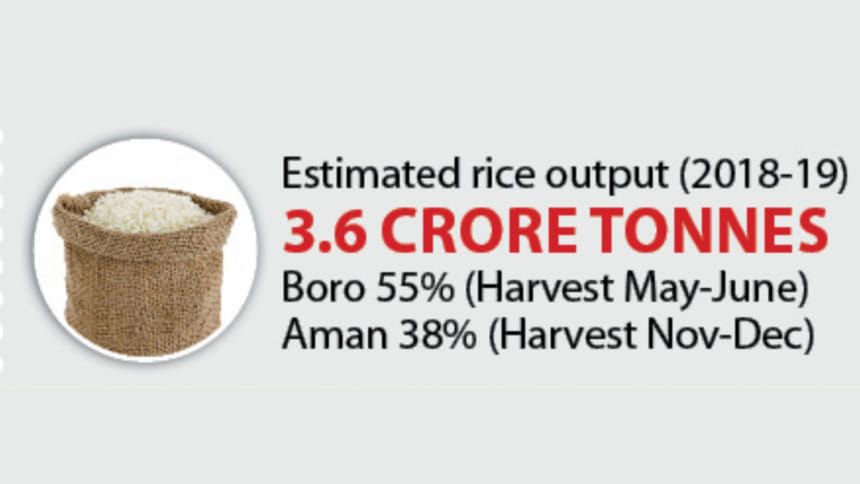Rice gets pricier

After soaring prices of onions, consumers now have to deal with rice prices creeping up over the last few weeks.
The rising rice prices question the claims of surplus by millers and their demand for cash incentives to export the grain to invigorate the paddy market and save the farmers from losses.
All rice varieties saw jumps in prices owing to supply shortfall, declining stocks of paddy, government procurement of 6 lakh tonnes of paddy, and exports, claimed traders.
Data of the Trading Corporation of Bangladesh (TCB) shows that depending on quality, retail prices of the cereal rose between 4 percent and 10 percent a kg in Dhaka city since November 10. This translates to Tk 2 to Tk 6 rise per kg.
In Dinajpur, a major rice growing district, the price of a sack of rice (50 kg) rose by Tk 300.
Rice prices started rising when farmers are harvesting the second biggest paddy crop, Aman. Last year, they produced 1.40 crore tonnes of the crop.
The biggest harvest is Boro and it fetched 1.94 crore tonnes of paddy this year.
These two crops account for 93 percent of the total annual rice output, 3.60 crore tonnes in fiscal year 2018-19, according to preliminary estimate of Bangladesh Bureau of Statistics (BBS).
The remaining seven percent is met by scattered Aus crop.
Amid a production excess, rice and paddy prices started falling since October last year and they were low until last month. Farmers had been protesting for not getting fair price, and millers had been pleading for export incentives so that they could clear the surplus.
“Given the production of the last two seasons, and consumption requirement, there is supposed to be a surplus. So, it is not clear why the price has increased,” said Quazi Shahabuddin, former director general of Bangladesh Institute of Development Studies.
Hopefully, this hike will not last once Aman harvest begins in full swing, he said.
There should be around 30 lakh tonnes of surplus rice, said an official of the agriculture ministry.
Azizul Islam, a farmers’ leader in Dinajpur, said farmers do not have any Boro paddy. All the paddy over the last month and a half have gone to large millers, he said.
Abdul Matin, owner of Titas Rice Agency at Mohammadpur Krishi market, a wholesale depot of rice in the capital, said, “This is not fully clear to us why millers are increasing prices. But there are speculations that stock of premium- and medium-quality grains, especially those grown once a year, are not that good.
“That is why, it appears that millers think they would be able to sell slowly. They are trying to make a quick buck.”
Millers, however, said prices of premium varieties, including Miniket and BR-28, increased as stocks were declining due to increased consumption.
Nirod Boron Saha, president of the Naogaon Dhan O Chal Aratdar Babshayee Samity, (a rice, paddy traders’ body), said, “As the prices of rice had been low for several months, people consumed finer grains more. This has created a shortage in the market. That is why those who have stocks are now selling slowly.”
He said that in Naogaon, Miniket price increased to Tk 2,250 per sack from Tk 1,800 of three weeks ago. Prices of other varieties have not increased that much in our area, he said.
KM Layek Ali, general secretary of the Bangladesh Auto Major and Husking Mills Association, said, “Prices of paddy have increased after the government declared it was buying more grain [6 lakh tonnes of paddy] from the farmers.”
Responding to a question, he said the demand for paddy also increased as there has been some moves made for exporting the grain.
The commerce ministry has so far approved export of around one lakh tonnes of rice. The ministry is yet to decide on permitting export of another 1 lakh tonnes, said a senior official. It plans to allow shipment of 2 lakh tonnes in total.
The news of rice being exported has an impact on the local market, said Reza Humayun Kabir Chowdhury Shamim, president of Dinajour Auto Rice Mills Association.
Saidul Islam, a retailer at Kushtia municipal market, shared his experience of visiting the country’s largest rice hub in Khajanagar on Thursday. Khajanagar has 290 rice mills.
“We suddenly came to know at mill gate that price of all varieties have increased.”
Three weeks ago Miniket was selling for Tk 37-38 a kg at mill gates, now it is Tk 42-43, according to millers and traders there.
Contacted, Agriculture Secretary Md Nasiruzzaman said it was not possible to simply explain the price hikes.
“But one thing I understand is that an upward trend in rice price is good news for those who are harvesting paddy. From that perspective, it is a positive symptom,” he said, adding that government’s announcement of 6 lakh tonnes of paddy purchase directly from growers might have impacted the market indirectly.
“Procurement will begin on November 20 and listing of farmers is on,” he said, adding that there might be no artificial crisis related to rice.
CONSUMERS TO SUFFER
While all these are going on, it’s the consumers who are suffering.
Azaharul Islam of Dinajpur town said, “Not only onion and rice, prices of every essential is high in the market.
“How can a kg of onions reach Tk 260.”
Blaming traders for such hikes, he said if there were any market monitoring, such a trend could have been contained.
Shahanaz Begum, who lives in Mohammadpur, said her family used to consume 14kg of onions a month. “Now we have already reduced it by 80 percent.
“At this time, higher prices of rice will add to the burden on fixed-income families, like ours. We will have no choice but to go for coarse rice,” she said.
“It would be very unfortunate to see prices of rice to go up after farmers had set fire to their paddy fields in protest after failing to get fair prices. Now farmers will not get higher prices that we will pay. Instead millers and middlemen will profit.”


 For all latest news, follow The Daily Star's Google News channel.
For all latest news, follow The Daily Star's Google News channel. 



Comments